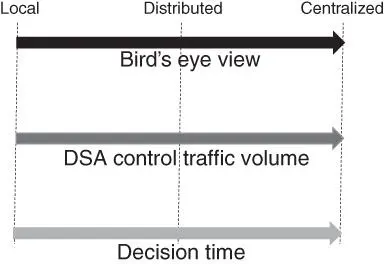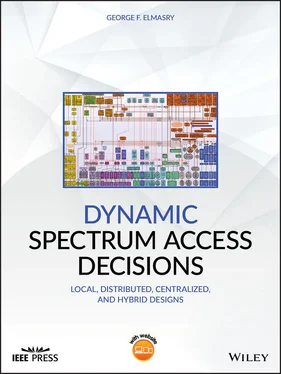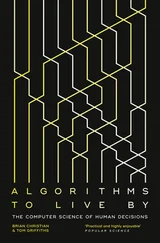As alluded to in the previous chapter, the DSA design may not stop at the local decision fusion and the solution may rely on cooperative distributed decision fusion or the use of a centralized spectrum arbitrator. Decision fusion can be made locally, in a distributed way and/or in a centralized arbitrator. This chapter covers the DSA design approaches that need to be thought of in cognitive networks, taking into consideration a variety of reasons to include the optimization of control traffic volume, the speed of making DSA decisions, the interdependency between DSA decisions and other cognitive networking processes, and the need for the different hierarchies of DSA decisions to work in harmony.
To make the best case for using a hybrid DSA design, this chapter uses examples from military communications systems where spectrum access needs to be more dynamic and the networks are heterogeneous and hierarchical. This book makes the case for considering hybrid DSA design in most applications. The second part of the book emphasizes approaches that can be common between different applications and areas where the DSA design approach may differ. In the second part of the book, Chapter 5 emphasizes the concept of developing DSA capabilities as a set of cloud services available at the different network hierarchical entities, which further emphasizes the hybrid DSA design consideration. Chapter 6 focuses on dynamic spectrum management for commercial cellular 5G systems. The cellular 5G dynamic spectrum management design is also a hybrid approach. Chapter 8 covers the inclusion of co‐site interference mitigation as a subset of DSA cloud services, which also emphasizes the need for hybrid DSA design approaches.
4.1 Reasons for Using Hybrid DSA Design Approaches
The case of designing DSA solutions for a mix of heterogeneous hierarchical MANETs is the best example that can be used to illustrate the reasons for using a hybrid DSA design. Figure 4.1shows examples of the trade space that can face the design of DSA capabilities. With heterogeneous hierarchical MANETs, there is a need for a centralized spectrum arbitrator and there could be good design reasons for creating local, distributed cooperative and centralized DSA techniques. As Figure 4.1shows, moving DSA decisions more towards distributed and centralized decision fusion can increase the bird's eye view (the overarching) understanding of the spectrum use map in the entire area of operation. The tradeoff here is the possibility of increasing the DSA control traffic volume and the increase in decision response time. Obviously, there is a trade space and one must be cognizant of the impact of this trade space depending on the specifics of the cognitive networking system under design.

Figure 4.1Trade space to be considered for hybrid DSA decision fusion.
In a cognitive networking system we are faced with the following:
1 Control traffic volume is not an issue because we have an abundance of bandwidth.
2 DSA decision time can be long because the systems can create stable topology due to limited or no mobility.
3 The design is required to avoid processing at the lower hierarchy network nodes because of limited processing capabilities and power constraints.
In this specific example, the design may consider moving the DSA computational complexity more towards centralized decision making. However, in most systems, one will have to consider a hybrid approach in light of the trade space illustrated in Figure 4.1. Even when designing a distributed cooperative DSA system for a single network, there is a room to consider a mix of local and distributed cooperative decision fusion.
There is no magic bullet that suits every communications system when it comes to designing a hybrid DSA system. There is a trade space that can lead to designing different decision fusion techniques at the different hierarchical entities of the system. However, there are guidelines the design can follow. It is always better to increase the bird's eye view of the spectrum map, it is always better to reduce DSA traffic volume, and decision response times must be appropriate and must meet the system's requirements. The following section presents decision fusion cases that can be helpful to the reader to reach a good design approach for the different types of cognitive wireless networking systems.
DSA design has to create metrics that evaluate the performance of the system in real time and through post‐processing, as covered in Chapter 5. Considering Figure 4.1, it is easy to conceptualize creating a metric for decision time trade space to be “response time” in microseconds, milliseconds or seconds depending on the system. It is also easy to conceptualize creating a metrics for DSA control traffic volume trade space to be “control traffic volume” in bps or packets per second. The design has to also create metrics to evaluate the bird's eye view trade space. The reader can refer back to Chapter 1, Section 1.2for the comprehensive DSA design aspects and see how the bird's eye view considerations can lead to creating metrics that evaluate this trade space, which may include the following:
1 Measuring DSA decisions' rippling. This metric can measure how long a theater‐based DSA decision can last before another decision has to be made. A good centralized spectrum arbitrator should make DSA decisions that last.
2 Adapting to traffic demand. If spectrum resources are allocated more where traffic demand is high, this will result in higher throughput efficiency of the heterogeneous networks and this higher throughput efficiency can be manifested in established network performance metrics such as packet or message completion ratio, packet delay, packet delay variation (jitter), and packet loss.
3 Avoiding hidden nodes. A bird's eye view capability should overcome the hidden node phenomena and reduce the likelihood of mistakenly using a primary user's spectrum. This metric can be the measuring of the number of complaints from a primary user. example 2
By the end of this chapter, the reader should realize that Figure 4.1oversimplified the trade space areas in order to illustrate the most important aspects of this trade space. Other factors such as the used antennas' technologies, the use of licensed spectrum, unlicensed spectrum or a mix of both, and the interactions between the cognitive DSA process and other cognitive processes the system uses add more dimensions to this trade space.
4.2 Decision Fusion Cases
Let us consider the case of sensing the presence of a signal where the local decision fusion engine was able to collect a knowledge repository that can be expressed as depicted as in Figure 4.2. This repository is illustrated in Figure 4.2with three different scenarios of the RSSI collected samples. Scenario 1 represents the case of low noise variance, scenario 2 represents the case of medium noise variance, and scenario 3 represents the case of high noise variance. The local knowledge repository and its associated cognitive engine were able to select a decision threshold based on the detected energy levels where the gray dots to the left of the decision threshold represent the energy detected in the absence of the sensed signal and the black dots to the right of the decision threshold represent the energy detected in the presence of the signal.

Figure 4.2Local decision fusion based on single‐dimensional knowledge base. 5
Читать дальше














